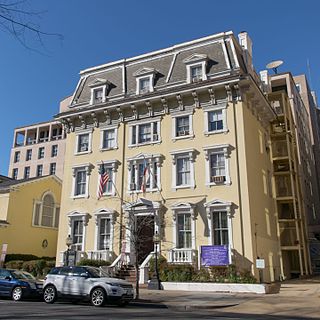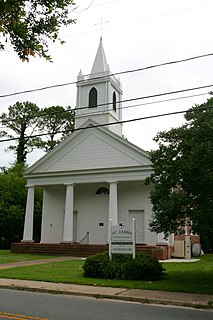
Bruton Parish Church is located in the restored area of Colonial Williamsburg in Williamsburg, Virginia, United States. It was established in 1674 by the consolidation of two previous parishes in the Virginia Colony, and remains an active Episcopal parish. The building, constructed 1711–15, was designated a National Historic Landmark in 1970 as a well-preserved early example of colonial religious architecture.

St. Bartholomew's Church, commonly called St. Bart's, is a historic Episcopal parish founded in January 1835, and located on the east side of Park Avenue between 50th and 51st Street in Midtown Manhattan, in New York City. In 2018, the church celebrated the centennial of its first service in its Park Avenue home.

Christ Episcopal Church is a historic Episcopal church located at 43 South Broadway in Tarrytown, New York. Topped by a modest tower, the ivy-covered red brick church was built in 1837 and maintains an active congregation to the present day. The church also includes the San Marcos Mission, a Spanish-language ministry.

Christ Church is an Episcopal church located at 118 North Washington Street in Alexandria, Virginia. Constructed as the main church in the Church of England's Fairfax Parish, the building was designed by Col. James Wren, a descendant of Sir Christopher Wren. To finance construction of the church, the Fairfax Vestry raised 31,186 pounds of Oronoco tobacco from parishioners. Construction began in 1765, under the direction of James Parsons. After four years, the church was still unfinished. The vestry relieved Mr. Parsons of his duties as overseer of the construction. John Carlyle accepted the position and handed the keys of the completed building over to the vestry in February 1773.

St. Luke's Church, also known as Old Brick Church, or Newport Parish Church, is a historic church building, located in the unincorporated community of Benns Church, near Smithfield in Isle of Wight County, Virginia, United States. It is the oldest church in Virginia and oldest church in British North America of brick construction. According to local tradition the structure was built in 1632, but other evidence points to a date of 1682; see Dating controversy.
Merchant's Hope was the name of a plantation and church established in the Virginia Colony in the 17th century. It was also the name of an English sailing ship, Merchant's Hope, which plied the Atlantic bringing emigrants to Virginia in the early 17th-century. The Merchant's Hope was owned by a man named William Barker who was a wealthy English merchant and mariner who patented land in Virginia.

St. Ambrose Cathedral is a historic building located in downtown Des Moines, Iowa, United States. It serves as a parish church and as the seat of the Diocese of Des Moines in the Catholic Church. The cathedral, along with the adjoining rectory, was listed on the National Register of Historic Places in 1979.

Bremo Slave Chapel, constructed in 1835 and located in Bremo Bluff, Virginia, United States, is the only slave chapel known to exist in the Commonwealth of Virginia. This Gothic Revival structure originally served as a place of worship for the slaves at the Bremo Plantation of General John Hartwell Cocke. Cocke was deeply concerned with the religious and moral state of his slaves, which drove him to construct this chapel.

St. Martin's Episcopal Church is a historic Episcopal church located on Route 113 at the intersection with Route 589 in Showell, Worcester County, Maryland. Much of the original Flemish bond brick structure is retained. Built as the first parish church of Worcester Parish, which had been established in 1753, it was started in 1756 and completed in 1759. Attendance dwindled after St. Paul's Episcopal Church was established in nearby Berlin in 1824, and by the end of the century the facility was used only sporadically.

St. James Church, Santee, also known as St. James Episcopal Church, Santee, is a historic church located in a remote portion of Francis Marion National Forest in Charleston County, South Carolina. Built in 1768, it is a remarkably sophisticated expression of fashionable Georgian architecture in a remote area, and was designated a National Historic Landmark in 1970 for its architectural significance. It is located on the west side of the Old Georgetown Road, several miles north of South Carolina Highway 46 and McClellanville.

Yeocomico Church is a historic Episcopal church in Westmoreland County in the U.S. state of Virginia. The original wooden structure was built in 1655, but replaced in 1706 by a structure built of locally fired bricks. It is now the main church of historic Cople parish, which also includes the older Nomini Church, and St. James Church in Tidwells, Virginia The parish hall is in Hague, Virginia. Yeocomico Church, the fourth oldest in the state, was designated as a National Historic Landmark in 1970.

Ashburton House, also known as St. John's Church Parish House or the British Legation, is a historic house at 1525 H Street NW, on Lafayette Square in Washington, D.C. Built in 1836, it is notable as the residence of Lord Ashburton in 1842, during which time negotiations took place there culminating the Webster–Ashburton Treaty. This settled a long list of border disputes between the U.S. and the British provinces that are now Canada, and ended the Aroostook War. It was declared a National Historic Landmark in 1973. It presently serves as the parish house for St. John's Episcopal Church.

Trinity Episcopal Church in Danville, Kentucky was one of the first churches organized in the Episcopal Diocese of Kentucky. Trinity Church is the oldest in-use church structure in Danville and the oldest continuously used Episcopal church building in the Episcopal Diocese of Lexington as well as the second oldest in Kentucky. It is listed in the National Register of Historic Places.

St. Paul's Church is an historic Episcopal church located near the village of Fairlee, southwest of Chestertown, Kent County, Maryland. St. Paul's Church is one of the original thirty parishes created in 1692 by an Act of the General Assembly declaring the Church of England as the established religion of the Province of Maryland. The Georgian-styled building, completed in 1713, is the second-oldest Episcopal church on the Eastern Shore of Maryland.

St. James Church is a historic Episcopal church building at 86-02 Broadway in the Elmhurst neighborhood of Queens in New York City. It is the city's oldest surviving Anglican building and Church of England mission church. It is also alternatively called the Old St. James Church to distinguish it from the St. James Episcopal Church two blocks away.

St. Thomas' Episcopal Church is located on Leedsville Road in Amenia Union, New York, United States. It is a mid-19th century brick church designed by Richard Upjohn in the Gothic Revival architectural style, built for a congregation organized shortly before.

St. James Church is a historic Episcopal Church on Drummondtown Road near Back Street in Accomac, Virginia, United States. Originally established as a chapel of ease for Accomack Parish in the seventeenth century, the present St. James Church was erected in 1838 as the town then known as Drummondtown grew as the county seat. In recognition of its Greek Revival design and interior trompe-l'oeil frescos, St. James Church was listed on the National Register of Historic Places in 1969. It is also a contributing building of the Accomac Historic District which was created in 1992.

St. Stephen's Church, also known as St. Stephen's Episcopal Church, is an historic church located at 6807 Northumberland Highway, Heathsville, Northumberland County, in the Northern Neck of Virginia. Built in 1881, it was designed in the Carpenter Gothic style by T. Buckler Ghequiere. On December 28, 1979, it was added to the National Register of Historic Places. It remains in use by an active parish in the Episcopal Diocese of Virginia. It is located in the Heathsville Historic District.

St. Mary's Catholic Church is a parish church of the Diocese of Davenport. The church is located at the corner of St. Mary's and Washburn Streets in the town of Riverside, Iowa, United States. The entire parish complex forms an historic district listed on the National Register of Historic Places as St. Mary's Parish Church Buildings. The designation includes the church building, rectory, the former church, and former school building. The former convent, which was included in the historical designation, is no longer in existence.

The Cathedral Church of St. Peter is an Episcopal cathedral in St. Petersburg, Florida, United States. It is the seat of the Diocese of Southwest Florida. It 2004 it was included as a contributing property in the Downtown St. Petersburg Historic District on the National Register of Historic Places.























